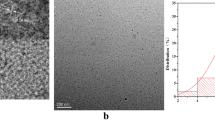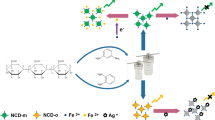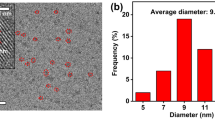Abstract
In this work, an “on-off-on” fluorescent probe based on Ni-MOF functionalized Nitrogen-doped carbon quantum dots (Ni-MOF-NCDs) was developed. Ni-MOF-NCDs was characterized by FT-IR, TEM, SEM, and XPS. The presence of Fe (III) will reduce the fluorescence intensity of Ni-MOF-NCDs and “turn off” the fluorescence signal at emission peak of 390 nm, while the signal can be “turn on” after the addition of ascorbic acid (AA). The Ni-MOF-NCDs was established as an “on-off-on” fluorescent probe for the detection of Fe (III) and AA with the linear ranges of 0.029-8.0 µg/mL and 0.263-18.0 µg/mL, respectively. The method has been successfully applied to the detection of water samples and foods with satisfactory recovery. The experimental results showed that Ni-MOF-NCDs not only had the fluorescence properties of NCDs, but also had the adsorption performance of Ni-MOF.








Similar content being viewed by others
Data Availability
All data generated or analyzed during this study are included in this published article.
References
Zhao L, Wang Y, Zhao X et al (2019) Facile synthesis of nitrogen-doped carbon quantum dots with chitosan for fluorescent detection of Fe3+. Polym (Basel) 11:1731–1731
O’Connell PJ, Gormally C, Pravda M, Guilbault GG (2001) Development of an amperometric L-ascorbic acid (Vitamin C) sensor based on electropolymerised aniline for pharmaceutical and food analysis. Anal Chim Acta 431:239–247
Zhu Y, Pan D, Hu X et al (2017) An electrochemical sensor based on reduced graphene oxide/gold nanoparticles modified electrode for determination of iron in coastal waters. Sens Actuators B: Chem 243:1–7
Gökmen V, Kahraman N, Demir N, Acar J (2000) Enzymatically validated liquid chromatographic method for the determination of ascorbic and dehydroascorbic acids in fruit and vegetables. J Chromatogr A 881:309–316
Lunvongsa S, Oshima M, Motomizu S (2006) Determination of total and dissolved amount of iron in water samples using catalytic spectrophotometric flow injection analysis. Talanta 68:969–973
Güçlü K, Sözgen K, Tütem E et al (2005) Spectrophotometric determination of ascorbic acid using copper(II)-neocuproine reagent in beverages and pharmaceuticals. Talanta 65:1226–1232
Xu XY, Ray R, Gu YL et al (2004) Electrophoretic analysis and purification of fluorescent single-walled carbon nanotube fragments. J Am Chem Soc 126:12736–12737
Mintz KJ, Zhou Y, Leblanc RM (2019) Recent development of carbon quantum dots regarding their optical properties, photoluminescence mechanism, and core structure. Nanoscale 11:4634–4652
Konar S, Kumar BNP, Mahto MK et al (2019) N-doped carbon dot as fluorescent probe for detection of cysteamine and multicolor cell imaging. Sens Actuators B-Chemical 286:77–85
Song Y, Zhu CZ, Song JH et al (2017) Drug-Derived Bright and Color-Tunable N-Doped Carbon Dots for Cell Imaging and Sensitive Detection of Fe3 + in Living Cells. ACS Appl Mater Interfaces 9:7399–7405
Bechet D, Couleaud P, Frochot C et al (2008) Nanoparticles as vehicles for delivery of photodynamic therapy agents. Trends Biotechnol 26:612–621
Park Y, Yoo J, Lim B et al (2016) Improving the functionality of carbon nanodots: doping and surface functionalization. J Mater Chem A 4:11582–11603
Shen Z, Zhang C, Yu X et al (2018) Microwave-assisted synthesis of cyclen functional carbon dots to construct a ratiometric fluorescent probe for tetracycline detection. J Mater Chem C 6:9636–9964
Liu H, Li RS, Zhou J, Huang CZ (2017) Branched polyethylenimine-functionalized carbon dots as sensitive and selective fluorescent probes for N-acetylcysteine via an off-on mechanism. Analyst 142:4221–4227
Li J, Xu O, Zhu X (2021) A facile green and one-pot synthesis of grape seed-derived carbon quantum dots as a fluorescence probe for Cu(ii) and ascorbic acid. RSC Adv 11:34107–34116
Chen D, Gao H, Chen X et al (2017) Excitation-Independent Dual-Color Carbon Dots: Surface-State Controlling and Solid-State Lighting. ACS Photonics 4:2352–2358
Yang YZ, Xiao N, Cen YY et al (2019) Dual-emission ratiometric nanoprobe for visual detection of Cu(II) and intracellular fluorescence imaging. Spectrochimica Acta Part a-Molecular and Biomolecular Spectroscopy 223:117300
Xu OW, Wan SY, Zhang YH et al (2021) A unique dual-excitation carbon quantum dots: Facile synthesis and application as a dual-“on-off-on” fluorescent probe. Sens Actuators B: Chem 340:129904
Wan SY, Xu OW, Zhang YH et al (2021) Pyridine Ionic Liquid Functionalized MOF-5 Coupled with High-Performance Liquid Chromatography for Analysis of Allura Red in Food Samples.Food Analytical Methods:950–960
Dong YQ, Cai JH, Fang QQ et al (2016) Dual-Emission of Lanthanide Metal-Organic Frameworks Encapsulating Carbon-Based Dots for Ratiometric Detection of Water in Organic Solvents. Anal Chem 88:1748–1752
Fan L, Wang Y, Li L, Zhou J (2020) Carbon quantum dots activated metal organic frameworks for selective detection of Cu(II) and Fe(III). Colloids Surf A 588:124378
Lin X, Gao G, Zheng L et al (2014) Encapsulation of strongly fluorescent carbon quantum dots in metal-organic frameworks for enhancing chemical sensing. Anal Chem 86:1223–1228
Shu Y, Lu Q, Yuan F et al (2020) Stretchable electrochemical biosensing platform based on Ni-MOF composite/Au nanoparticle-coated carbon nanotubes for real-Time monitoring of dopamine released from living cells. ACS Appl Mater Interfaces 12:49480–49488
Xiao Y, Wei W, Zhang M et al (2019) Facile Surface Properties Engineering of High-Quality Graphene: Toward Advanced Ni-MOF Heterostructures for High-Performance Supercapacitor Electrode. ACS Appl Energy Mater 2:2169–2177
Yang Q, Hong H, Luo Y (2020) Heterogeneous nucleation and synthesis of carbon dots hybrid Zr-based MOFs for simultaneous recognition and effective removal of tetracycline. Chem Eng J 392:123680
Wang H, Sun C, Chen XR et al (2017) Excitation wavelength independent visible color emission of carbon dots. Nanoscale 9:1909–1915
Ye Q, Yan F, Luo Y et al (2017) Formation of N, S-codoped fluorescent carbon dots from biomass and their application for the selective detection of mercury and iron ion. Spectrochimica Acta - Part A: Molecular and Biomolecular Spectroscopy 173:854–862
Li Z, Yu H, Bian T et al (2015) Highly luminescent nitrogen-doped carbon quantum dots as effective fluorescent probes for mercuric and iodide ions. J Mater Chem C 3:1922–1928
Liang Y, Xu L, Tang K et al (2020) Nitrogen-doped carbon dots used as an “on-off-on” fluorescent sensor for Fe3 + and glutathione detection. Dyes Pigm 178:108358
Devi JSA, Salini S, Anulekshmi AH et al (2017) Fe (III) ion modulated L-DOPA protected gold nanocluster probe for fluorescence turn on sensing of ascorbic acid. Sens Actuators B-Chemical 246:943–951
Dutta Choudhury S, Chethodil JM, Gharat PM et al (2017) PH-Elicited Luminescence Functionalities of Carbon Dots: Mechanistic Insights. J Phys Chem Lett 8:1389–1395
Luo X, Zhang W, Han Y et al (2018) N,S co-doped carbon dots based fluorescent “on-off-on” sensor for determination of ascorbic acid in common fruits. Food Chem 258:214–221
Chandra S, Laha D, Pramanik A et al (2016) Synthesis of highly fluorescent nitrogen and phosphorus doped carbon dots for the detection of Fe3+ ions in cancer cells. Luminescence 31:81–87
Atchudan R, Edison TNJI, Aseer KR et al (2018) Highly fluorescent nitrogen-doped carbon dots derived from Phyllanthus acidus utilized as a fluorescent probe for label-free selective detection of Fe3 + ions, live cell imaging and fluorescent ink. Biosens Bioelectron 99:303–311
Rao HB, Ge HW, Lu ZW et al (2016) Copper nanoclusters as an on-off-on fluorescent probe for ascorbic acid. Microchim Acta 183:1651–1657
Gong X, Liu Y, Yang Z et al (2017) An “on-off-on” fluorescent nanoprobe for recognition of chromium(VI) and ascorbic acid based on phosphorus/nitrogen dualdoped carbon quantum dot. Anal Chim Acta 968:85–96
Zu FL, Yan FY, Bai ZJ et al (2017) The quenching of the fluorescence of carbon dots: A review on mechanisms and applications. Microchim Acta 184:1899–1914
Yan F, Bai Z, Zu F et al (2019) Yellow-emissive carbon dots with a large Stokes shift are viable fluorescent probes for detection and cellular imaging of silver ions and glutathione. Microchim Acta 186:113
Rani L, Kaushal J, Srivastav AL, Mahajan P (2020) A critical review on recent developments in MOF adsorbents for the elimination of toxic heavy metals from aqueous solutions. Environ Sci Pollut Res 27:44771–44796
Liao S, Zhao X, Zhu F et al (2018) Novel S, N-doped carbon quantum dot-based “off-on” fluorescent sensor for silver ion and cysteine. Talanta 180:300–308
Funding
This work was supported by the National Natural Science Foundation of China (21375117) and a project funded by the Priority Academic Program Development of Jiangsu Higher Education Institutions and Postgraduate research/practice innovation program of Jiangsu province.
Author information
Authors and Affiliations
Contributions
All authors contributed to the study conception and design. Material preparation, data collection and analysis were performed by Ouwen Xu, Shuyu Wan, Jing Yang, Hanyang Song, Luzheng Dong, Ji Xia, and Xiashi Zhu. The first draft of the manuscript was written by Ouwen Xu. All authors read and approved the final manuscript.
Corresponding author
Ethics declarations
Ethical approval
Not applicable.
Consent to participate
Not applicable.
Consent for publication
All the authors are consent to publishing the paper.
Conflict of interest
The authors declare they have no competing interests.
Additional information
Publisher’s Note
Springer Nature remains neutral with regard to jurisdictional claims in published maps and institutional affiliations.
Rights and permissions
About this article
Cite this article
Xu, O., Wan, S., Yang, J. et al. Ni-MOF Functionalized Carbon Dots with Fluorescence and Adsorption Performance for Rapid Detection of Fe (III) and Ascorbic Acid. J Fluoresc 32, 1743–1754 (2022). https://doi.org/10.1007/s10895-022-02982-7
Received:
Accepted:
Published:
Issue Date:
DOI: https://doi.org/10.1007/s10895-022-02982-7




